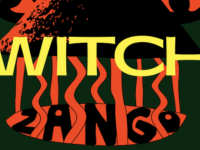Witch ‘n’ Monk are Mauricio Velasierra and Heidi Heidelberg, whose music is a mix of Latin American flutes, unconventional vocals, electric guitar and electronics. Once known as “Bitch ‘n’ Monk,” their new name far better circumscribes the magical connotations which abound in their music.
A mix of punk, free form and jazzy compositions of texture and complexities, this music is almost guaranteed to be different from anything you heard before. The pair have played across Europe and their performances have included prestigious venues like the Royal Festival Hall, Paradox and Dunkers and jazz festivals including London, Manchester and Umea as well as venues of a different nature such as Italian skate parks or among the thorn bushes in overgrown East London gardens.
Their eponymous album, out on John Zorn’s Tzadik imprint, follows 2016’s critically acclaimed We Are Peering Over. Over that time, Witch ‘n’ Monk have built on their intimate artistic partnership. Interestingly, their journey has been as impulsive as their music. One day, they abandoned the structures in their lives, packed clothes, a 20kg sack of rice and their home studio into a van, and drove to the secluded Welsh mountains where the core energy of Witch ‘n’ Monk was first captured as a series of improvisations. The process continued in an old Stasi bunker in East Berlin, and later a tower block inhabited by punks.
The story of this album is as much a love-story of two minds meeting over an insane dedication to creating symphonies, as it is an artistic response to the disintegration of truth, reality and traditional structures – an engagement with shamanic naturalism and mysticism through music. Over the course of Witch ‘n’ Monk, Colombian traditional flute virtuoso Mauricio Velasierra makes use of his vast arsenal of wind instruments, with melodies that range from the savage to the sublime. Andean Sikus’ pan-pipes are ripped from their usual folk context and transformed into a giant puffing lung, and keyless quena flutes soar eerily above intricately orchestrated string arrangements.
Anarchic soprano and guitarist Heidi Heidelberg shape-shifts through vocal timbres and characters, from genuinely unhinged chants of half-words to soulful tango-esque storytelling. The pair say of the recording: “The momentum for this album was a commitment to abandoning that egoistic 20th century idea of the lone (male) composer writing his opus. That’s why we started by recording what was essentially stream-of-consciousness music, completely free improvisations which we then used as the sonic canvas.”
When the album was partially complete and on its way to being released, a spontaneous nocturnal exchange brought their demo to the attention of John Zorn. He signed Witch ‘n’ Monk to his label Tzadik but left them total artistic freedom to bring it to completion. Speaking about the album Tzadik says there’s “a touch of Frank Zappa lyricism and a radical punk aesthetic. … Heidi Heidelberg and Mauricio Velasierra craft a dramatically bizarre vocal music from another dimension! Intertwining dark/light, feminine/masculine, composed/improvised and punk/romantic, dreamlike improvisations are sampled, manipulated and reinvented through the lens of contemporary music and pop. You have never heard anything quite like Witch ’n’ Monk.”
Armed with half a million minutes of obsessional composition, the pair invited guest drummers from across the creative music scene to be part of the sound. Mercury Music Award nominee Seb Rochford (Patti Smith, Polar Bear, Sons of Kemet) appears on “Coal Mine,” while Swiss rising-star drummer Nicolas Stocker lent his impeccable groove to “Escarbando.” Faced with typically Witch ’n’ Monk arhythmic breaks and asymmetrical time signatures, Gidon Carmel was drafted in for “The Cage.” Each drummer added their own character to the tracks, with the aim of retaining spontaneity in every aspect of the music.
“In the isolation of the Welsh mountains, the river Ystwyth in the background roaring with the night’s rainfall, melodies, grooves, characters and stories just occurred to us,” Witch ’n’ Monk say. “It’s a total fusion of our two minds, in collaboration with nature. Each piece is a journey, a water molecule that leaves the boggy source and meanders downhill, eventually meeting the sea. As a listener you just have to abandon your expectations of form and allow yourself be guided downstream. That’s why we call our music ‘fluid form.'”
The opening track “Escarbando” is a symphonic composition which wends its way through many different sonic landscapes. A raw string introduces a strong drum rhythm and a multi-voiced choir that morphs into a sci-fi Borg-like rap. The following section is a seductive cascade of synth chords accompanying Heidelberg’s signature self-made language of ghost words that induce an urge to seek meaning. The hiatus of the piece is a battle between post-punk junkyard jazz instruments and a tight Amazonian groove played on Gaitas, which are sacred indigenous twin flutes made of cactus wood, charcoal and beeswax.
Witch ’n’ Monk deliver a final thumping prophetic message inspired by the Kogui people of the Sierra Nevada in Colombia. There are hints of Hagen, Crass and many other edge-of-punk bands with strong characters. The rock chord lines at times offer a heaviness that counteracts the transcendence in the vocals, which include Spanish male voices over an offset rhythm. This in effect defines the multi-cultural essence of the piece and the finish (“do not take more than what you need”) in clear echoed vocals is a very effective message given the different national draws in the inputs.
“Coal Mine” is somehow beautiful, yet incredibly emotive with its coloratura vocals and pin-point accuracy in the rhythms. The song tells a sorry tale and electronica overlay and warping is used to emphasize both the voice and instrumentation. Mauricio Velasierra dips into his larder of flutes on this track and introduces some quite beautiful over tones, while the drums of Seb Rochford add their strength and fortitude.
“Self” opens with a furious quena flute call over open-structured drum lines that introduce a story – told in Spanish and English – of a woman whose wavering belief brings her to the edge of the valley paralyzed as she prepares for a leap of faith. Heavy electronic distorted bass and drum grooves build up the vertiginous tension, mirroring this woman’s journey. At the height of the piece, a digitally effected quena solo crosses into the surreal, giving way to a gentle spell-like verse sung accompanied by charango (a traditional Andean 10-stringed instrument), and evolves into a soaring flute and tribal drum outro. The complexity of the narrative is echoed by the depth and texture in the soaring arrangements; “Self” is a stand-out track.
“Pagan’s Storm and the Sea Ballad” is opened with calling flute, into which the vocals drop – inferring an eerie sense of unease, set up with the over-dubbed flutes and strong, insistent vocals. The beautiful, esoteric vocal solo over guitar is mesmeric. “The Cage” is a Latin-influenced number with string backing and an orchestral flavor to the opening sections, topped by ethereal vocals which are echoed briefly and atmospherically by the violin. The track tells the tale of feeling trapped, and the mixing and engineering help create a sense of ever-increasing frustration and search for freedom.
“The Gathering” feels tribal, anarchic yet somehow also grounded because of the strength of the classical compositional elements. The flutes here are used to create different levels of harmonic structure which fill the arrangement wonderfully, especially the double-tongued sections where the voice can be heard under the notes, adding the sense of the emotive urgency to the track.
“Outchant” is different, charming and highly rhythmic, with the voices used to add rhythms and percussive elements, along with the guitar. The slower-paced section in the middle, topped out by Heidi’s crazy-lady vocals is ear-catching and provides a great contrast to the return to the pre-set rhythms. “Gualchovan” is deeper, and speaks directly to the tribal part of us all. There are strong rhythms, emphatic ghost language vocals and a surreal visitation to music which unites different languages and cultures through its combination of ancient sounds and modern engineering.
By its nature, Witch ‘n’ Monk transcends definition. It cheerfully sits on the outer reaches of contemporary music, jazz-punk and experimental music, exuding a creative freedom that guides the listener into an unusual and boldly original sound world. Witch ‘n’ Monk may place themselves on the outskirts of what can be called convention in musicality but they possess an allure which draws and charms a wide audience.
What is very clear is a sense of entitlement almost, the unwavering belief that this music is vital and has something to say – and while listening, you are in agreement. Energy-imbued and managing to be different yet at the same time drawing on much of the musical inferences which have been apparent on the edges since the late 1970s, this pair charmingly add modern vibes. Witch ‘n’ Monk never feels retro in its outlook or musicality. Gloriously different, wonderfully listenable and offering something more each time.
- Wabi Sabi – ‘The Love Insane’ (2024) - March 24, 2024
- James McGowan Ensemble – ‘Reaching In’ (2023) - December 10, 2023
- Defne Sahin – ‘Hope’ (2023) - November 19, 2023




